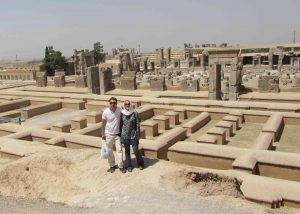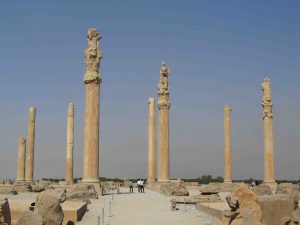Deborah James advocated for Fair Trade at Global Exchange from 1993 – 2005, and now serves as a member of the Global Exchange Board. She is currently the Director of International Programs at the Center for Economic and Policy Research. She recently participated in the Citizen Diplomacy Delegation to Iran with Reality Tours. In a series of posts, she shares with us her experience.
July 5, 2010 Persepolis
The UNESCO World Heritage site of Persepolis is the heart of our tour through Iran’s history. At the time it was built, starting around 520 BC, it was the ceremonial capital of the largest empire that the world had ever known. At its height, the Persian Empire included much of present-day Central Asia all the way to Pakistan and as far north as Kazakhstan, the Caucasus, Turkey, parts of Greece, Mesopotamia and the Levant, and even parts of Egypt and Libya. The destruction of this masterpiece in 330 BC by the Macedonian Alexander the Great’s army represents an enormous global cultural loss.
Initiated by Cyrus the Great, founder of the first Persian Empire, the Achaemenids, Persepolis includes the remains of the former palaces of the Achaemenid kings including Darius the Great, Xerxes and Artaxerxes. (Cyrus himself is buried at Pasargad nearby). We are fortunate that most of the ruins were buried in desert sand for centuries, so that some bas-reliefs remain, famous for depicting kings and courtiers and gift-bearing representatives of nations (Baylonians, Assyrians, Armenians, Egyptians, Scythians, Indians, Arabs, Bactrians, etc) of the Persian Empire.
 Coming from a country where many citizens think the era of Jim Crow laws is ancient history, it is overwhelming to contemplate what it must be like to be from a country that is steeped in 2,500 years of documented, organized history (in additional to several thousand years of continuous habitation.) And every Iranian we speak with is well aware of this history, as if it were yesterday.
Coming from a country where many citizens think the era of Jim Crow laws is ancient history, it is overwhelming to contemplate what it must be like to be from a country that is steeped in 2,500 years of documented, organized history (in additional to several thousand years of continuous habitation.) And every Iranian we speak with is well aware of this history, as if it were yesterday.
From Persepolis we drive to Esfahan, the last stop on our trip before returning to Tehran. On the way, as on all days, we are plied with a variety of snacks: roasted pistachios or fresh walnuts; juicy cherries and mulberries, perfectly ripe apricots and peaches, and fresh Persian melon; baklava, delicious saffron ice cream, and mouthwatering sweets made with rosewater and pistachio; and heavenly pomegranate juice. And of course, ubiquitous service of tea with fresh dates!
Read the rest of Deborah James’ ‘Journey to Iran‘ blog posts.

